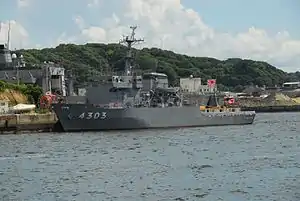 Amakusa at Sasebo Naval Base in 2007. | |
| History | |
|---|---|
| Name |
|
| Builder | Universal, Keihin |
| Laid down | 3 December 2002 |
| Launched | 6 August 2003 |
| Commissioned | 16 March 2004 |
| Homeport | Sasebo |
| Identification | MMSI number: 431999677 |
| Status | in active service |
| General characteristics | |
| Class and type | Hiuchi, Auxiliary Multi-purpose Support (AMS) |
| Displacement | 980 long tons (1,000 t) |
| Length | 65 m (213 ft) |
| Beam | 12.0 m (39.4 ft) |
| Height | 5.8 m (19 ft) |
| Draft | 3.5 m (11 ft) |
| Propulsion | Diesel |
| Speed | 15 knots |
JS Amakusa is a Hiuchi-class Auxiliary Multi-purpose Support (AMS) ship of the Japan Maritime Self-Defense Force (JMSDF).[1]
The ship was built by Universal in Keihin and commissioned into service on 16 March 2004.[2] The primary mission of the Amakusa is to support training exercises of other ships, including shooting practice and torpedo launching practice.[3]
Service
This ship was one of several in the JMSDF fleet participating in disaster relief after the 2011 Tohoku earthquake and tsunami.[4] Akakusa was the second of two JMSDF ships which towed barges of fresh water from Yokosuka to the Fukushima I nuclear accidents. The water was used to replace the seawater being used in cooling efforts at the plant.[5]
On 22 May 2022, the Amakusa conducted surveillance on a PLAN destroyer near Miyako Island. [6]
Notes
- ↑ Werth, Eric. (2007). Naval Institute Guide to Combat Fleets of the World, p. 392., p. 392, at Google Books
- ↑ Global Security, AMS Hiuchi Class, ship list
- ↑ Global Security.org, AMS Hiuchi Class
- ↑ Seawaves, "Warships Supporting Earthquake in Japan" Archived 2011-03-23 at the Wayback Machine
- ↑ Taylor, Brock. "Second U.S. Navy Barge Sent to Support Fukushima Daiichi Nuclear Power Plant Cooling Efforts" (Filename:DOD_100148949), DVIDS (Defense Video & Imagery Distribution System). 26 March 2011; retrieved 20 Mar 2011
- ↑ "Chinese Carrier Strike Group Now Operating in East China Sea". 23 May 2022.
References
External links
 Media related to JS Amakusa (AMS-4303) at Wikimedia Commons
Media related to JS Amakusa (AMS-4303) at Wikimedia Commons- JMSDF, AMS-4303 あまくさ Amakusa